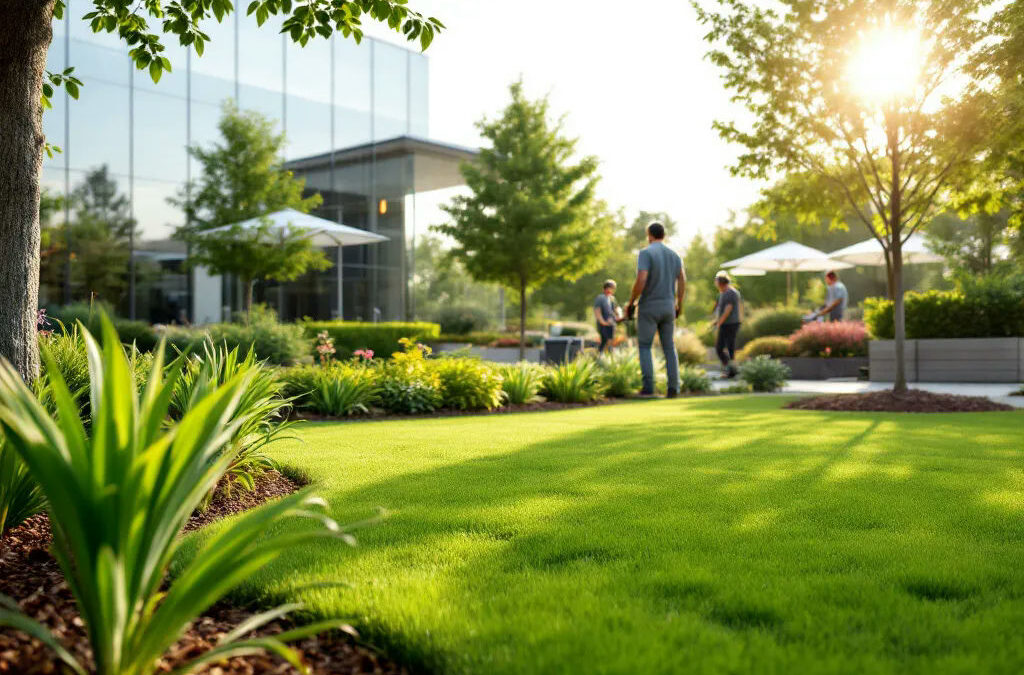I. Introduction
Eco-friendly lawn care refers to the use of sustainable and environmentally responsible practices to maintain outdoor spaces. In commercial properties, adopting such practices is essential not only for the health of the local ecosystem but also for the operational efficiency of businesses. Sustainable lawn care benefits both the environment and the bottom line by reducing costs, improving aesthetics, and enhancing brand reputation in a world increasingly focused on sustainability.
II. Key Principles of Eco-Friendly Lawn Care
A. Soil Health Management
One of the fundamental principles of eco-friendly lawn care is soil health management. Understanding the composition and nutrient levels of the soil is crucial; regular soil testing can guide effective amendment strategies. By applying organic amendments and natural fertilizers, businesses can promote robust soil health, leading to greener, more resilient lawns.
B. Water Conservation Techniques
Efficient water usage is another cornerstone of sustainable lawn care. Implementing advanced irrigation systems, such as drip irrigation paired with rain sensors, drastically reduces water waste. Additionally, incorporating drought-resistant landscaping can minimize reliance on water, ensuring that green spaces thrive even during dry spells.
C. Pest Management Strategies
Managing pests sustainably is vital for preserving the ecosystem. Integrated Pest Management (IPM) combines various techniques to control pests while minimizing harm to beneficial organisms. Utilizing natural pest deterrents and fostering a diverse landscape enhances the overall health of the lawn, reducing the need for chemical treatments.
III. Eco-Friendly Products and Tools
A. Organic Fertilizers and Their Benefits
Employing organic fertilizers can have a transformative effect on commercial landscaping. Unlike synthetic options, organic fertilizers improve soil structure, enhance microbial activity, and provide a slow-release source of nutrients. This results in healthier plants and reduced environmental impact, aligning with sustainable growth objectives.
B. Eco-Conscious Lawn Care Equipment
Utilizing eco-conscious tools is essential for maintaining an environmentally friendly commercial lawn. Electric mowers and battery-powered tools not only minimize carbon emissions but also provide quieter operation compared to gas-powered alternatives. Choosing manual tools when possible further reduces environmental footprints associated with maintenance.
C. Biodegradable and Non-Toxic Treatments
The widespread use of chemical treatments can have dire environmental consequences, making biodegradable and non-toxic options highly desirable. These products safeguard plant health while being safer for surrounding wildlife, pets, and people. By adopting such treatments, commercial properties can enhance their appeal while upholding ecological responsibility.
IV. Implementation of Eco-Friendly Practices
A. Planning and Designing Eco-Friendly Landscapes
The initial planning and design phase of landscaping sets the foundation for sustainable practices. Selecting native and drought-resistant plants is crucial, as they typically require less maintenance and water. Additionally, creating green spaces that enhance biodiversity can improve ecosystem services, such as pollination and natural pest control.
For more related commercial property improvement strategies, explore topics like what to expect during a commercial concrete installation project or how to choose the right concrete mix for your commercial project.
B. Regular Maintenance Practices
Maintaining eco-friendly lawns involves adapting practices to benefit the environment. Adjusting mowing heights can preserve grass health and encourage deeper root systems, while seasonal care tips help businesses adapt to changing weather patterns. Routine maintenance not only keeps lawns looking their best but also supports sustainable practices that lead to long-term success.
Read about key safety measures for commercial concrete pours or top 7 mistakes to avoid in commercial concrete construction for additional property care insights.
V. Benefits of Eco-Friendly Lawn Care for Commercial Properties
A. Cost Savings Through Reduced Water and Chemical Usage
Implementing eco-friendly lawn care leads to substantial cost savings for commercial properties. By reducing water consumption and minimizing the need for chemical treatments, businesses can lower their overall maintenance costs. This fiscal advantage makes sustainable practices not just environmentally friendly, but economically beneficial as well.
B. Enhanced Aesthetic Appeal for Tenants and Visitors
A beautifully maintained eco-friendly lawn can significantly enhance the aesthetic appeal of a commercial property. Well-designed green spaces create inviting environments for tenants and visitors alike, fostering a sense of community. This positive atmosphere can attract more tenants and clients, boosting business opportunities.
C. Positive Impact on Community and Brand Reputation
Adopting sustainable lawn care practices can enhance a business’s reputation as a responsible community member. Companies that prioritize eco-friendly practices are often viewed more favorably by consumers, leading to stronger brand loyalty. This reputation can translate into competitive advantages in a growing market that values sustainability.
VI. Case Studies and Success Stories
A. Examples of Commercial Properties Successfully Implementing Eco-Friendly Practices
Several commercial properties across the country have set exemplary standards in eco-friendly lawn care. From office complexes that installed native plant gardens to shopping centers benefiting from efficient irrigation systems, these examples showcase the effectiveness of sustainable methods. Their successes serve as inspiration for other businesses looking to implement similar practices.
Explore more commercial strategies such as a contractor’s guide to bidding on commercial concrete jobs profitably or differences between residential and commercial concrete applications.
B. Measurable Outcomes and Improvements
In these case studies, measurable outcomes such as reduced water usage, lower maintenance costs, and increased biodiversity were reported. These quantifiable benefits underscore not only the practicality of eco-friendly lawn care but also its positive impact on the environment. By adopting similar practices, other businesses can expect to yield similar results.
VII. Resources for Commercial Property Owners
A. Associations and Organizations Promoting Sustainable Lawn Care
Numerous associations and organizations advocate for sustainable lawn care techniques, providing resources and guidance. These platforms offer invaluable information on best practices and emerging innovations in the field. Engaging with these groups can help commercial property owners stay informed and inspired.
B. Local Experts and Consultants Available for Guidance
Working with local experts can provide tailored advice on implementing eco-friendly practices. Many counties and municipalities have sustainability consultants who specialize in helping businesses transition to greener operations. This local support often includes insights into region-specific horticultural challenges and solutions.
C. Online Resources and Tools for Eco-Friendly Landscaping
The digital landscape offers a plethora of online resources and tools dedicated to eco-friendly landscaping. From educational articles to forums connecting business owners with like-minded individuals, the information available can facilitate the learning process. Websites focused on sustainable practices can empower property owners with practical tips and strategies.
Also explore helpful topics such as understanding curing times for commercial concrete projects, the importance of reinforcement in commercial concrete work, how weather affects commercial concrete pours, and pre-pour checklist for large commercial concrete jobs.
VIII. Conclusion
Eco-friendly lawn care is more than just a trend; it’s an essential practice that benefits both the environment and the bottom line for commercial properties. By embracing sustainable techniques such as soil health management, water conservation, and organic pest control, businesses can create beautiful, resilient landscapes while reducing their environmental footprint and operational costs. The positive impacts extend beyond aesthetics, contributing to enhanced brand reputation and stronger community ties. With the right tools, resources, and expert guidance, transitioning to eco-friendly lawn care can yield long-term benefits that support both environmental and business success. Start implementing these practices today to create a greener, more sustainable future for your commercial property.


